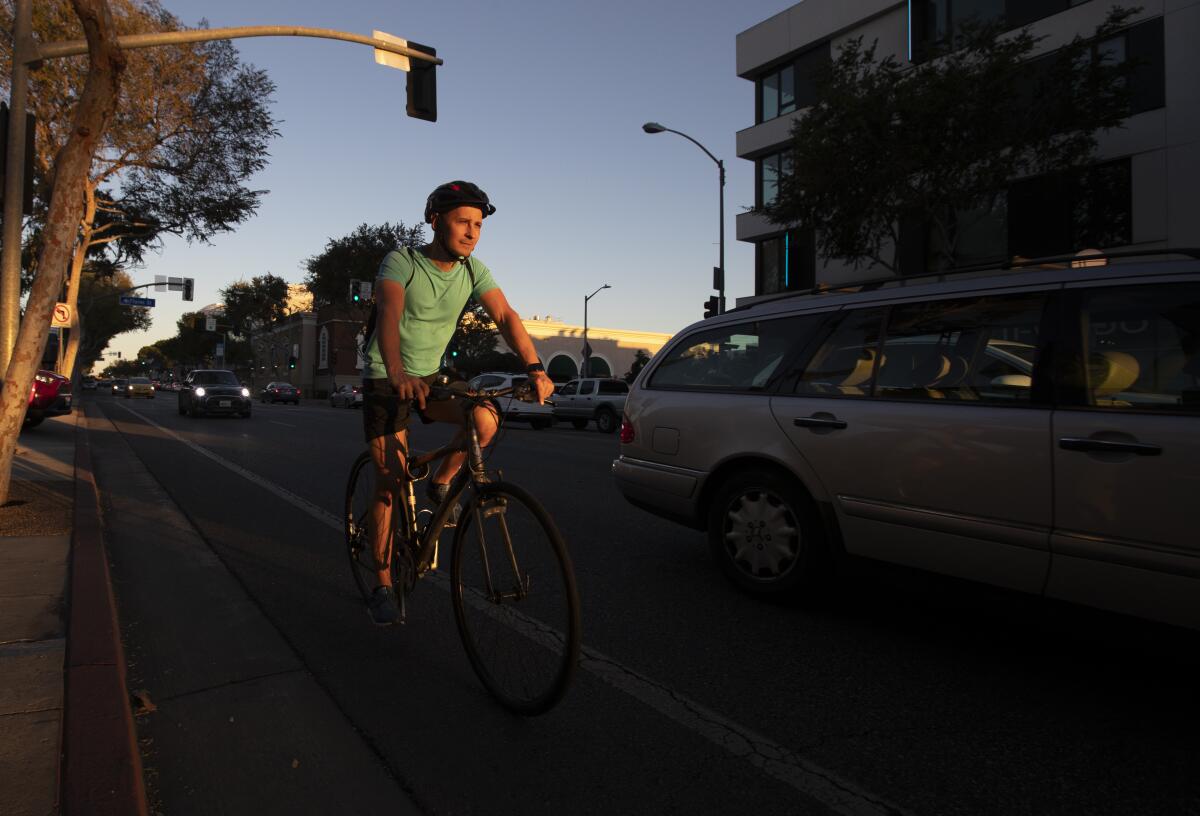Op-Ed: L.A. can no longer afford to push bikes and buses aside

Paul Koretz kills a bike lane on Melrose and fights a bus lane on Wilshire. Gil Cedillo and Mitch O’Farrell work together to kill a bike lane on Temple. Paul Krekorian kills a bike lane on Lankershim. David Ryu kills a bike lane on 6th Street. John Lee fought a bus lane on Nordhoff. All of these real events over the last few years have something in common: members of the Los Angeles City Council actively ignoring the city’s Mobility Plan 2035, part of the general plan passed by the council in 2016.
Maybe you’re thinking, “So what? I don’t use a bike or the bus in L.A.” But the persistent hostility toward the bike and bus lanes envisioned by that plan have real consequences for all of us, including those who drive and never bike or take the bus.
Our traffic and air quality are worse because of these actions. Because safe bike lanes are scarce, people who might be interested in biking — especially for short trips in their neighborhood — don’t risk it, out of self-preservation. And with an average car trip of just three miles (a 15-minute bike ride), there is huge potential to convert a lot of car trips to a bike or scooter. Same with the bus. Today, if you have access to a car, you will generally avoid the bus because it’s so slow. But if our buses had their own dedicated lanes — as laid out in Mobility Plan 2035 — they would fly past cars at rush hour and draw in new bus riders.
With nearly year-round perfect weather, a relatively flat city and an average trip of three miles, L.A. could get tens of thousands of cars off the road quickly, just by implementing its own plan and building the right infrastructure for car alternatives.
Sounds simple, right? It would be, except politicians are scared of upsetting constituents who drive. The hard truth is that there is no way to prioritize other modes of transportation without sacrificing some car convenience and space (on street parking and travel lanes), but the benefits to our city far outweigh the costs.
Another issue in Los Angeles is that we tend to build bike lanes in small segments based on the city’s repaving schedule. The problem here is that just like car lanes, bike (and bus) lanes really work well only as a network. Imagine if the 101 almost connected to the 405, and the 405 almost connected to the 10, and in the gaps, drivers faced a dirt road with potholes. How many cars would drive on those roads? Yet we ask the same of people on bikes today. Unless someone can get to where they need to go and feel safe for the entire journey, many won’t bother. That requires a network of protected bike lanes that connect to other protected bike lanes, criss-crossing the city.
Then there’s the issue of climate change. The disconnect between our transportation habits locally and climate change globally can no longer be ignored. In California, cars account for 28% of greenhouse gas emissions, the single largest source.
If you believe electric cars are going to “solve it all,” think again; electric cars cause carbon emissions during production, give off tire particulates when driven, necessitate mining for lithium, often charge from fossil fuel sources, and lead to the same demands for parking and road space as combustion cars, hogging space needed for high-quality bus and bike lanes. They also kill pedestrians and cyclists just as often as conventional vehicles; in the U.S., automobile accidents are the leading cause of death for people ages 1 to 54. Electric cars are not a silver bullet.
We need all candidates running for mayor and City Council in 2022 to be leaders on this issue. The mayor especially must lead by action, not just talk, as it is today. Individual council members should not be allowed to block road changes prescribed in the Mobility Plan. We need citywide implementation, across district lines; the average Angeleno has no idea where one district ends and one begins, and those boundaries should not determine where a bike or bus lane mysteriously stops or starts.
Los Angeles has long incentivized cars above all other modes of transportation. Climate-friendly transportation should be the new default, with incentives and infrastructure investment to match. It makes no sense to install bike share stations without building a network of safe bike lanes. It’s foolish to pour billions into new subway lines but also permit five-story parking podiums attached to new residential buildings above the stations.
We can no longer claim to care about climate change but not be willing to make real changes to help fight it. The city must take tangible, coherent steps to solve it. We already have a guide. Our leaders just need to implement their own plan.
Michael Schneider is the founder of Streets for All.
More to Read
A cure for the common opinion
Get thought-provoking perspectives with our weekly newsletter.
You may occasionally receive promotional content from the Los Angeles Times.










